A Who’s Who of CT Salamanders
By Becky Barton
“Blood laced with a natural antifreeze pumps through the veins of wood frogs. They rest suspended, somewhere between life and death, awaiting spring’s arrival in frozen winter forests. Beneath a blanket of decaying leaves, salamanders are waiting, too. Tap, tap. It’s time for the race. Each year in late March and early April, from New Jersey to Maine, forest-dwelling amphibians like spotted salamanders and wood frogs wake up from their winter homes and migrate during the night to vernal pools for breeding. Some animals travel through the woods, never to be seen by humans, while others cross broken habitat, trying sometimes fatal journeys across streets. When weather is warm and wet, hundreds to thousands of the animals migrate at once, in what’s called a ‘big night‘.” (JoAna Klein, NYTimes, 3/3/17)
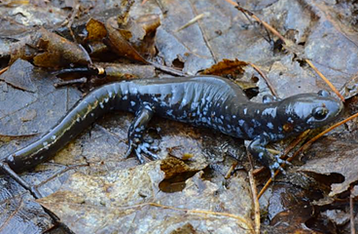
1 - Blue-Spotted Salamander
- ENDANGERED
- Deciduous forest associated with riparian wetlands, mostly west of the CT river. Prefer marsh or swamp-like habitat.
- Vernal pools for egg deposition and larval development.
- 5-4.5 inches in length.
- Black with blue flecks on legs, belly and tail.
- Raise their tails and release toxins.
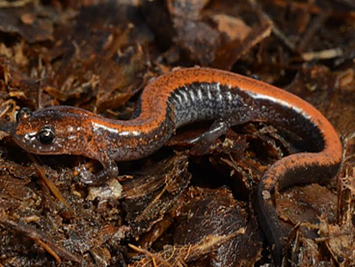
2 - Eastern Red-Backed Salamander
- Common throughout the state in forested habitat.
- 8 -4.0 inches in length.
- Coloring varies from the “red-backed” phase to the “lead-backed” phase. Stripes lead down to the tail. Dark colored underbelly.
- May flee, but also may use red stripe as warning to predators.
- Completely terrestrial life cycle. The young hatch fully developed from eggs deposited under logs and stones. Skips aquatic larval stage.

3 - Eastern or Red-Spotted Newt
- Three stage life cycle. Aquatic larva, terrestrial “eft” stage found in forests across the state. Aquatic adults found in permanent water bodies in and around forested habitats.
- 4 – 4.3 inches in length.
- Terrestrial “eft” stage is bright orange to olive-brown with red spots.
- Aquatic adult is olive-green with two rows of red spots. Underbelly is light yellow with dark speckles.
- Newts will posture when threatened, can release toxins through skin.
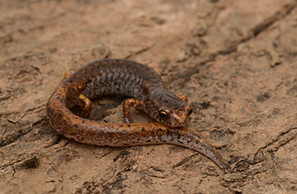
4 - Four-Toed Salamander
- Common in wetlands and uplands, especially red maple wetlands with sphagnum moss.
- 7 – 3.3 inches in length.
- Rusty brown. Noticeable white underbelly with small black or brown spots.
- Four toes on back feet.
- Will coil, can produce toxic secretions or may hold still and rely on camouflage if
- Lays their eggs under sphagnum moss in late spring. Females guard Aquatic larvae, terrestrial adults.
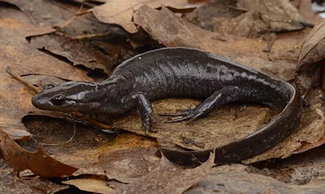
5 - Jefferson Salamander
- SPECIAL CONCERN
- Deciduous forests west of the CT River.
- Vernal pools for egg deposition and larval development very early spring.
- 5 to 6.5 inches. Brownish gray to dark brown with blue/silver flecks,
- Defense is to release toxic secretions.
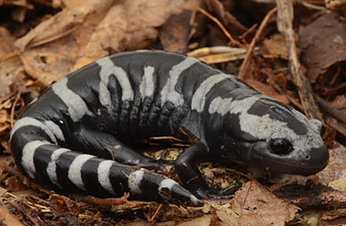
6 - Marbled Salamander
- Common throughout the state in deciduous forest, however prefers drier, almost sandy soil.
- Use permanent ponds for egg deposition in the FALL. Larvae overwinter in these ponds.
- 5 – 4.7 inches in length.
- Black with white cross-bands (males) and grayish cross-bands (females).
- Will raise rear legs and secrete toxins when threatened.
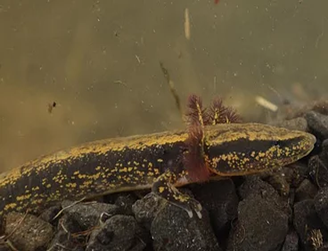
7 - Mudpuppy
- SPECIAL CONCERN.
- Large aquatic salamander only found in Connecticut River and Housatonic River drainages..
- 8 – 17 inches in length.
- Olive color with blackish mottling. Prominent bushy gills and a fin-like tail. Lighter colored
- Quick to escape predators. Can sense changes in water pressure to know when a predator is Makes a bark-like squeak when fleeing. Can secrete a toxin for defense.
- Mostly nocturnal, spend the day in burrows.

8 - Northern Dusky Salamander
- Common throughout the state in streams and seeps.
- 8 – 5.0 inches in length.
- Brown with white dorsal stripe. Black line near eye. Light colored underbelly.
- Will hold still or flee when threatened.
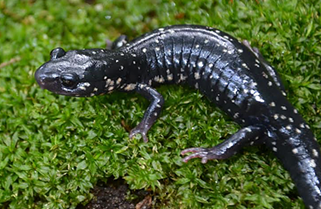
9 - Northern Slimy Salamander
- THREATENED
- Found in old growth forests and rocky slopes in western CT.
- 3 – 6 inches in length.
- Black with white speckles. Black underbelly.
- Will secrete slimy emission from the tail when handled.

10 - Northern Spring Salamander
- THREATENED
- Found in cold, spring fed streams in northern CT.
- 5 – 7.5 inches in length with flattened tail.
- Orange to salmon colored with reticulated brown pattern. Under belly is white.
- Releases noxious skin secretions. May posture or flee when threatened..
- Aquatic larvae, aquatic Breeds mid-October, females guards eggs in the water, eggs hatch in the spring.
- Predator of smaller salamanders.
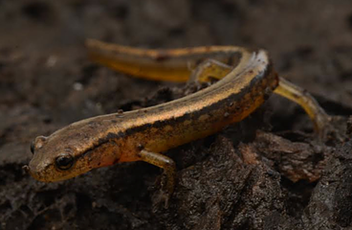
11 - Northern Two-lined Salamander
- Common throughout the state in streams and seeps.
- 8 – 4.3 inches in length.
- Gold to yellowish-brown with two parallel dark stripes extending onto tail with colored spots. Yellow underbelly.
- Will hold still or flee when threatened.
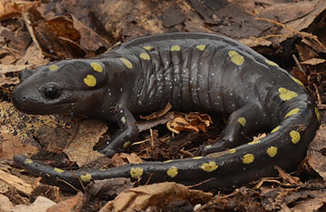
12 - Spotted Salamander
- Common throughout the state in deciduous forest.
- Use vernal pools for egg deposition and larval development. Found crossing roads in the early spring on warm rainy nights to breed.
- 7 – 7.8 inches in length.
- Grayish-black with two irregular rows of yellow spots.
